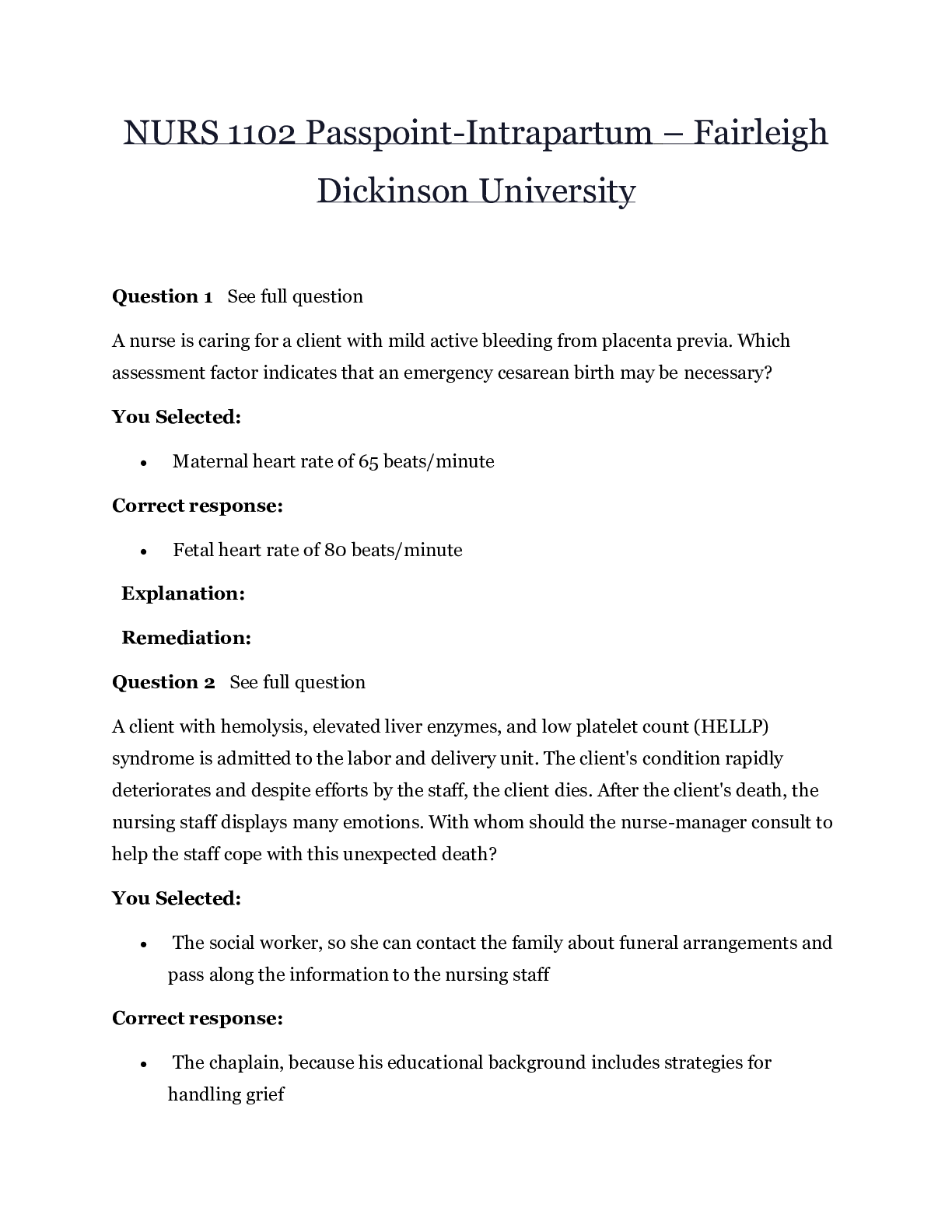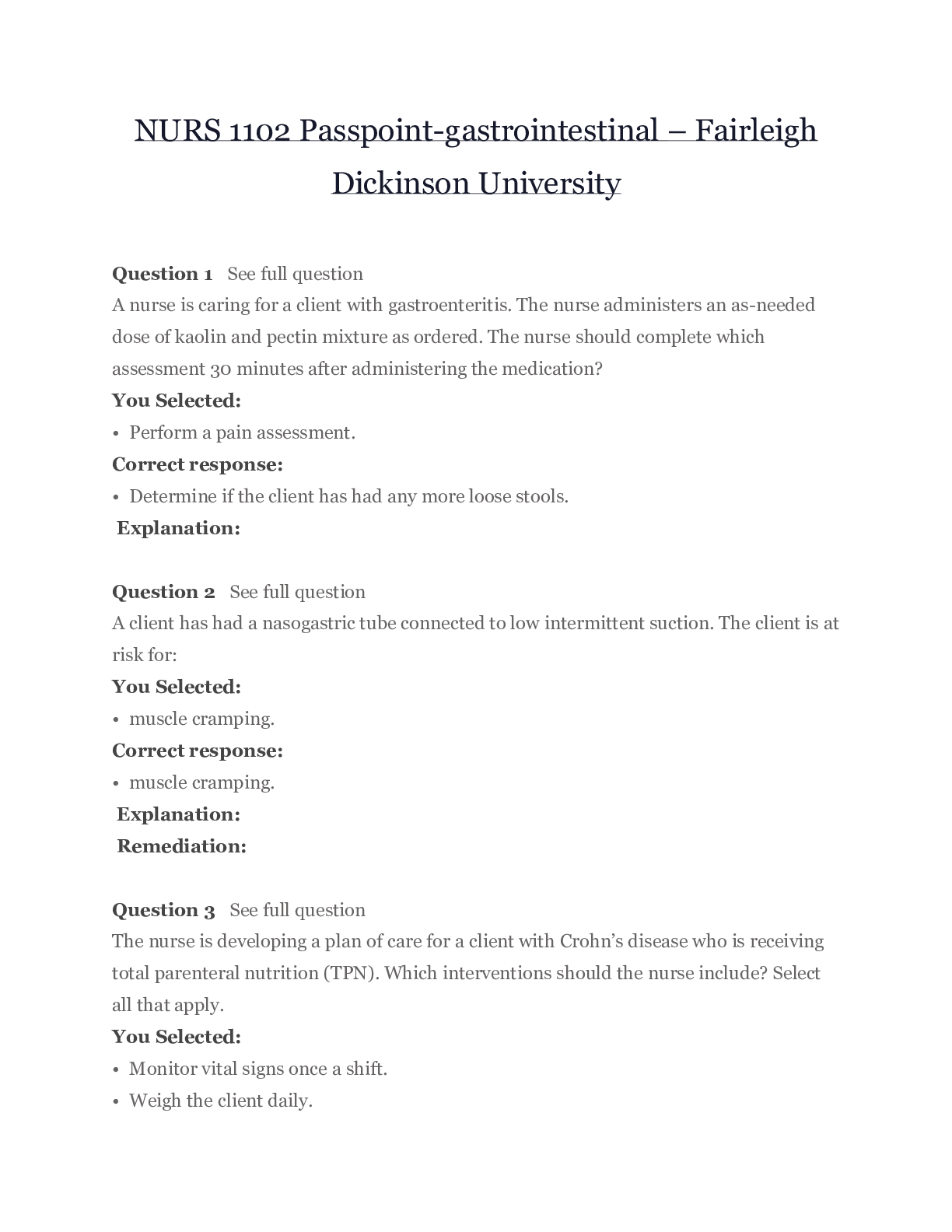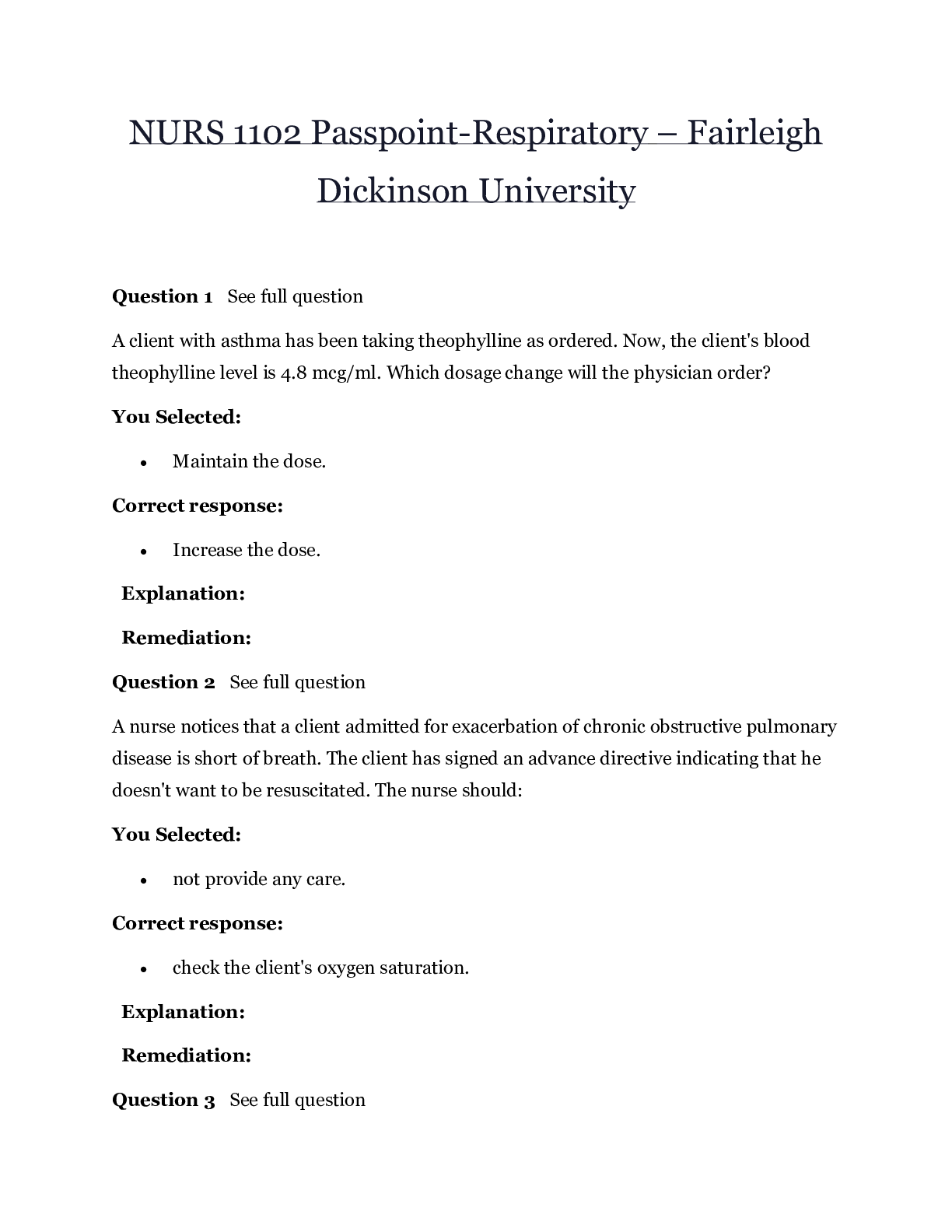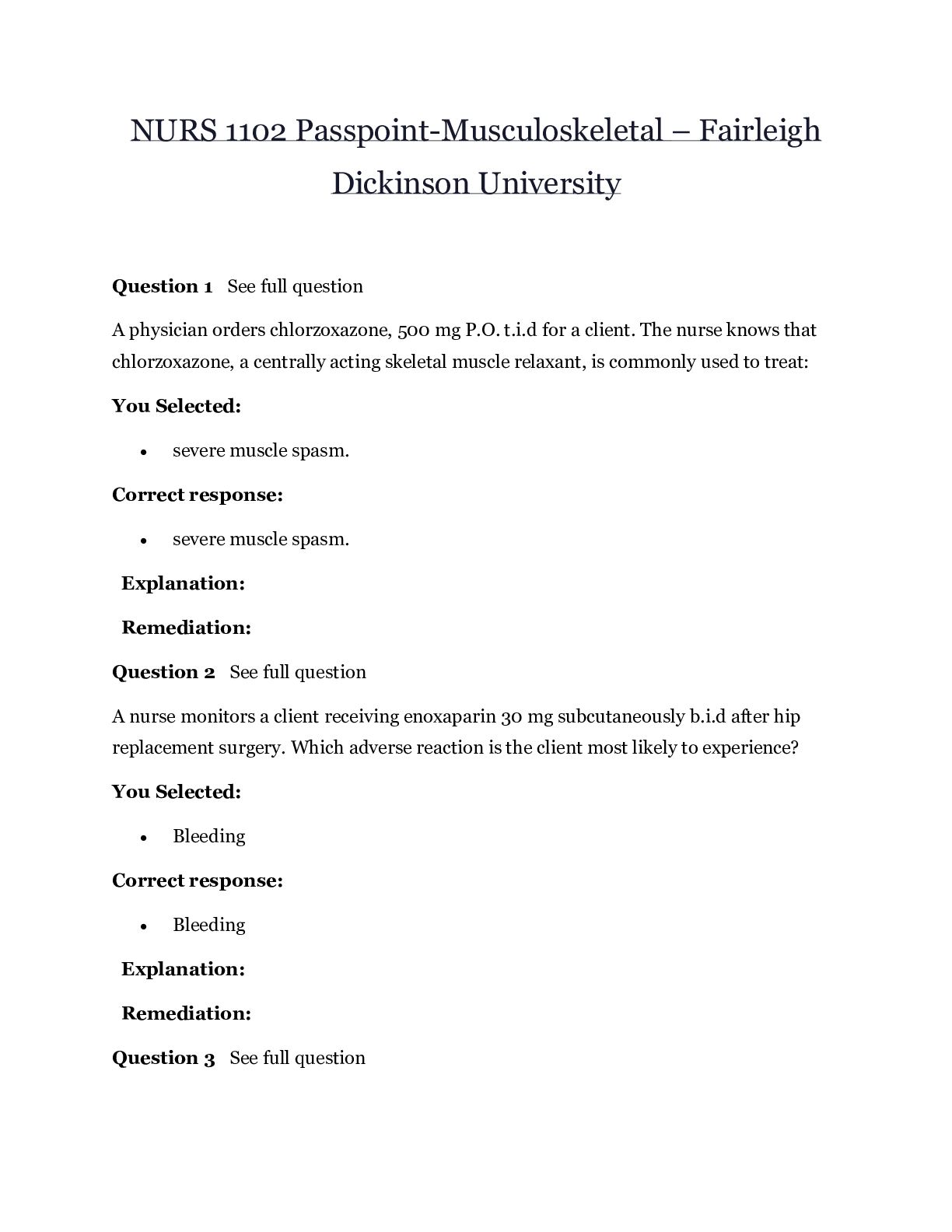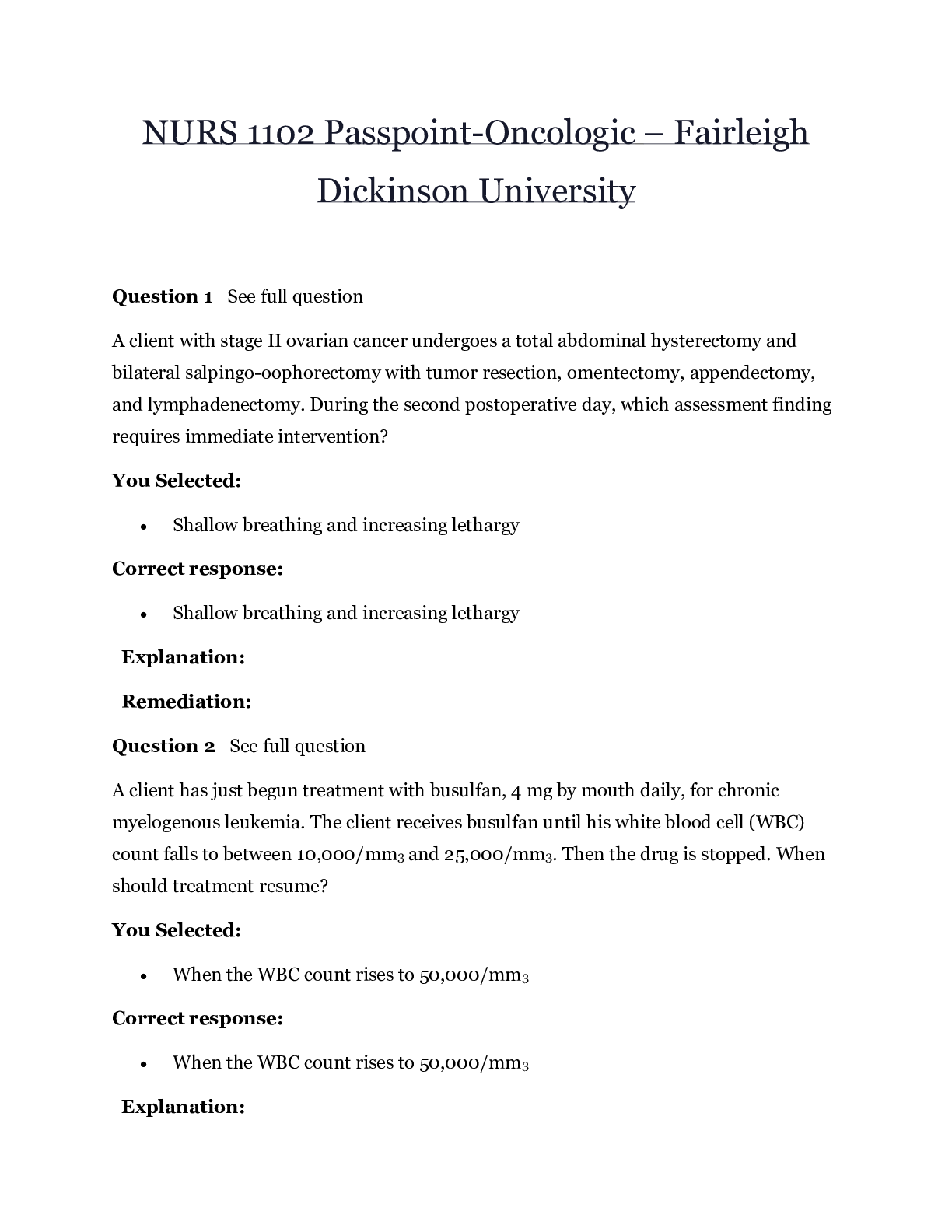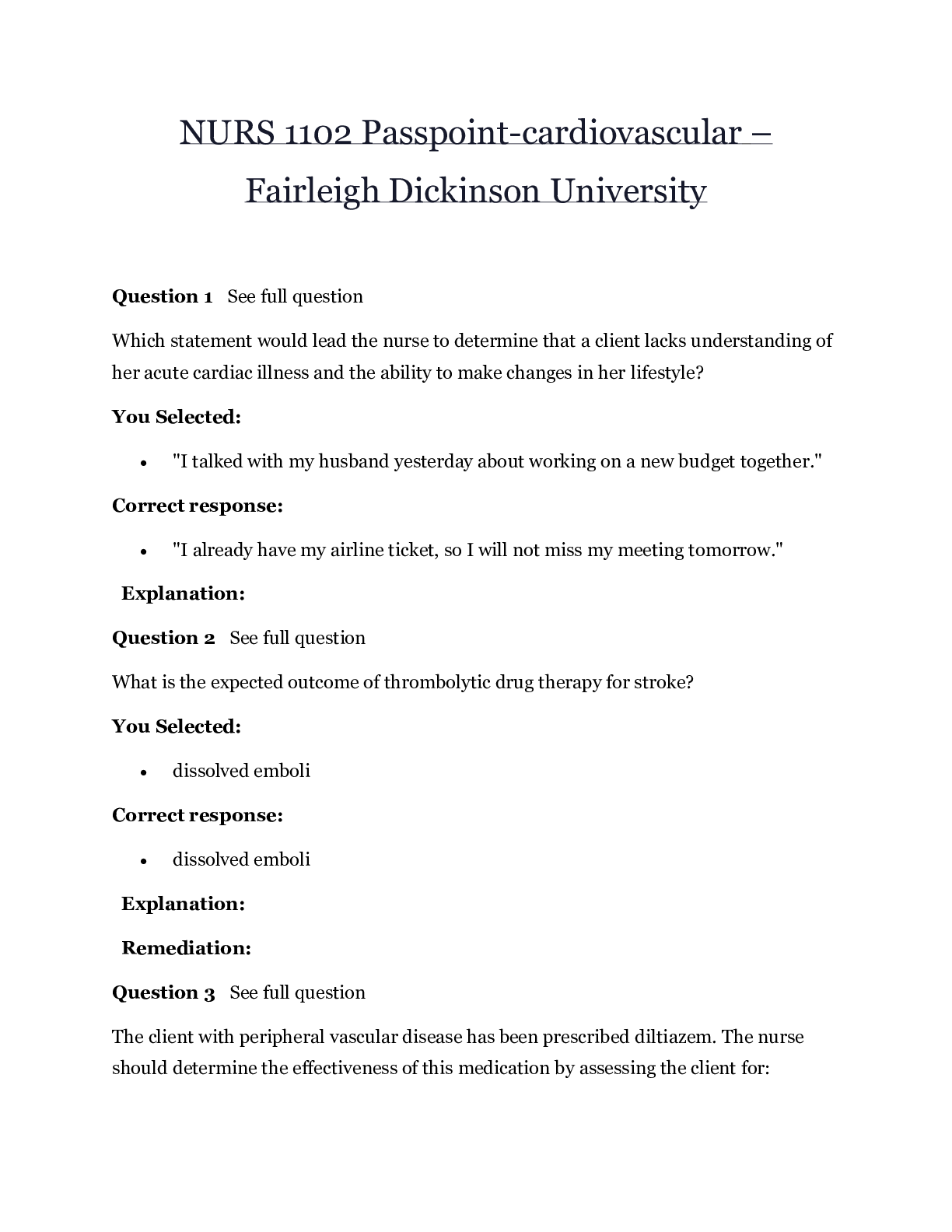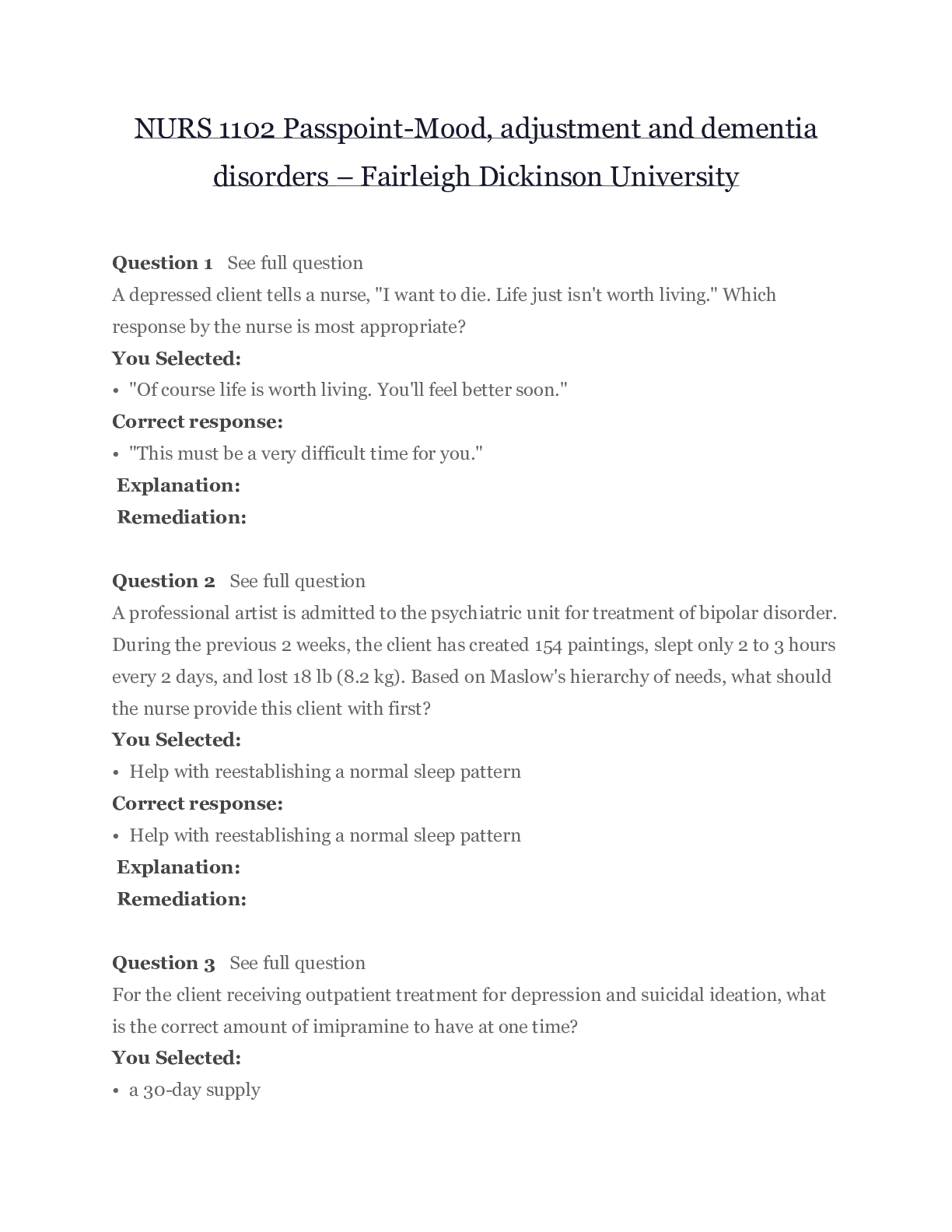*NURSING > EXAM > NURS 1102 Passpoint-Neuro – Fairleigh Dickinson University | NURS1102 Passpoint-Neuro (All)
NURS 1102 Passpoint-Neuro – Fairleigh Dickinson University | NURS1102 Passpoint-Neuro
Document Content and Description Below
NURS 1102 Passpoint - Neuro – Fairleigh Dickinson University Question 1 See full question A client comes to the emergency department complaining of headache, malaise, chills, fever, and a ... stiff neck. Vital sign assessment reveals a temperature elevation, increased heart and respiratory rates, and normal blood pressure. On physical examination, the nurse notes confusion, a petechial rash, nuchal rigidity, Brudzinski's sign, and Kernig's sign. What do these manifestations indicate? You Selected: • Increased intracranial pressure (ICP) Correct response: • Meningeal irritation Explanation: Remediation: Question 2 See full question What should a nurse do when administering pilocarpine? You Selected: • Apply pressure on the outer canthus to prevent adverse reactions. Correct response: • Apply pressure on the inner canthus to prevent systemic absorption. Explanation: Remediation: Question 3 See full question A registered nurse (RN) and licensed practical nurse (LPN) are administering medications on the neurologic floor. The LPN prepares to administer phenytoin to a client with a history of seizures. As the LPN walks into the room, she hands the medication to a nursing assistant. The LPN asks the nursing assistant to give the client the medication after completing the client's morning care. What should the registered nurse do? You Selected: • Take the medication from the nursing assistant and administer it. Correct response: • Remind the LPN that she must administer the medications herself. Explanation: Remediation: Question 4 See full question A nurse is caring for an older adult client with advanced Parkinson's disease. Which client statement about advance directives indicates a need for further instruction? You Selected: • "I know that I'll eventually be unable to make decisions. Signing an advance directive now will save my family grief." Correct response: • "I don't really need to sign anything. I'm depending on my physician to tell my family what to do if something bad happens." Explanation: Remediation: Question 5 See full question A nurse caring for a client who had a stroke is using the unit's new computerized documentation system. The nurse uses the information technology appropriately when she: You Selected: • documents medications before administration. Correct response: • documents medications after administration. Explanation: Remediation: Question 6 See full question A 70-year-old, previously well client asks the nurse, "I notice I have tremors. Is this just normal for my age?" What should the nurse tell the client? You Selected: • "You should have your blood pressure checked when this occurs." Correct response: • “You should report this to the health care provider because it may indicate a problem.” Explanation: Remediation: Question 7 See full question Following an infection, the client is having ototoxic effects of the vestibular branch of the acoustic nerve. The nurse should assess the client for: (Select all that apply.) You Selected: • tinnitus • vertigo • ataxia Correct response: • vertigo • nausea • ataxia Explanation: Question 8 See full question A client returns to the recovery room following left supratentorial surgery for treatment of a brain tumor. The nurse should place the client in which position to facilitate venous drainage? You Selected: • lying flat without a pillow with the client's head turned to the right Correct response: • head of the bed elevated to 30 degrees with the client's head in a neutral position Explanation: Question 9 See full question The nurse is caring for a client with an injury to the thalamus. The nurse should plan to: You Selected: • monitor the temperature of the bathwater. Correct response: • monitor the temperature of the bathwater. Explanation: Question 10 See full question Which statement would provide the best guide for activity during the rehabilitation period for a client who has been treated for retinal detachment? You Selected: • Activity level can return to normal; clients can resume regular aerobic exercises. Correct response: • Activity is resumed gradually; the client can resume usual activities in 5 to 6 weeks. Explanation: Remediation: Question 11 See full question A client with glaucoma is to receive 3 gtt of acetazolamide in the left eye. What should the nurse do? You Selected: • Ask the client to close his right eye while administering the drug in the left eye. Correct response: • Have the client look up while the nurse administers the eyedrops. Explanation: Remediation: Question 12 See full question As a first step in teaching a woman with a spinal cord injury and quadriplegia about her sexual health, the nurse assesses her understanding of her current sexual functioning. Which statement by the client indicates she understands her current ability? You Selected: • "I cannot have sexual intercourse because it causes hypertension, but other sexual activity is okay." Correct response: • "I can participate in sexual activity but might not experience orgasm." Explanation: Remediation: Question 13 See full question A client with a spinal cord injury who has been active in sports and outdoor activities talks almost obsessively about his past activities. In tears, one day he asks the nurse, “Why am I unable to stop talking about these things? I know those days are gone forever.” Which response by the nurse conveys the best understanding of the client’s behavior? You Selected: • "It is a simple escape mechanism to go back and live again in happier times." Correct response: • "Reviewing your losses is a way to help you work through your grief and loss." Explanation: Remediation: Question 14 See full question A client is at risk for increased intracranial pressure (ICP). Which finding is the priority for the nurse to monitor? You Selected: • decreasing systolic blood pressure Correct response: • unequal pupil size Explanation: Question 15 See full question The nurse is preparing a client with multiple sclerosis (MS) for discharge from the hospital to home. The nurse should tell the client: You Selected: • "Keep active, use stress reduction strategies, and avoid fatigue." Correct response: • "Keep active, use stress reduction strategies, and avoid fatigue." Explanation: Remediation: Question 16 See full question An unlicensed assistive personnel (UAP) is providing care to a client with left-sided paralysis. Which action by the UAP requires the nurse to provide further instruction? You Selected: • elevating the foot of the bed to reduce edema Correct response: • pulling up the client under the left shoulder when getting the client out of bed to a chair Explanation: Question 17 See full question After 5 days of hospitalization, a client who is receiving morphine sulfate for pain control asks for pain medication with increasing frequency and exhibits increased anxiety and restlessness. The vital signs are within normal ranges. What is a possible cause of this behavior? You Selected: • The client has developed tolerance to the dose of morphine. Correct response: • The client has developed tolerance to the dose of morphine. Explanation: Remediation: Question 18 See full question When determining how to administer analgesics to a client who has been receiving opiates for pain relief administered by injection, the nurse should consider using patient-controlled analgesia since it is more effective because: You Selected: • two opioids can be administered simultaneously. Correct response: • the client will control the amount of pain medication administered. Explanation: Remediation: Question 19 See full question A client is receiving cyclobenzaprine for management of a herniated lumbar disk. Which finding indicates the drug is providing the intended relief? You Selected: • The client is sedated. Correct response: • The client’s muscles are not in spasm. Explanation: Remediation: Question 20 See full question A client with a lumbar laminectomy ambulates for the first time after surgery and begins to feel faint. Which nursing action would be best until help arrives? You Selected: • Have the client close the eyes for a few minutes. Correct response: • Separate the feet to form a wide base of support and have the client rest against the nurse’s hip. Explanation: Question 21 See full question After cataract removal surgery, the nurse teaches the client about activities that can be done at home. Which activity would be contraindicated? You Selected: • performing isometric exercises Correct response: • bending over the sink to wash the face Explanation: Remediation: Question 22 See full question A client returns from surgery after a submucosal resection with nasal packing in place. The nurse should first: You Selected: • determine the degree of pain the client is experiencing. Correct response: • assess the degree of airway obstruction. Explanation: Question 23 See full question The client reports that the nasal packing is uncomfortable and asks when it will be removed. The nurse should tell the client the nasal packing is usually removed: You Selected: • after pain has diminished. Correct response: • 24 to 48 hours after surgery. Explanation: Remediation: Question 24 See full question The nurse is instructing a client with Ménière’s disease how to recognize vertigo. The nurse should tell the client to notice: You Selected: • a feeling that the environment is in motion. Correct response: • a feeling that the environment is in motion. Explanation: Remediation: Question 25 See full question After a plane crash, a client is brought to the emergency department with severe burns and respiratory difficulty. The nurse helps to secure a patent airway and attends to the client's immediate needs, then prepares to perform an initial neurologic assessment. The nurse should perform an: You Selected: • examination of the fundus of the eye. Correct response: • evaluation of the corneal reflex response. Explanation: Remediation: Question 26 See full question A client who was found unconscious at home is brought to the hospital by a rescue squad. In the intensive care unit, the nurse checks the client's oculocephalic (doll's eye) response by: You Selected: • touching the cornea with a wisp of cotton. Correct response: • turning the client's head suddenly while holding the eyelids open. Explanation: Remediation: Question 27 See full question When obtaining the vital signs of a client with multiple traumatic injuries, a nurse detects bradycardia, bradypnea, and systolic hypertension. The nurse must notify the physician immediately because these findings may reflect which complication? You Selected: • Shock Correct response: • Increased intracranial pressure (ICP) Explanation: Question 28 See full question A nurse is giving discharge teaching to a client with an eye injury. Which statement about preventing eye injuries should the nurse include? You Selected: • "Direct all spray nozzles away from your face before spraying." Correct response: • "Direct all spray nozzles away from your face before spraying." Explanation: Question 29 See full question Which nursing diagnosis takes highest priority for a client admitted for evaluation for Ménière's disease? You Selected: • Risk for injury related to vertigo Correct response: • Risk for injury related to vertigo Explanation: Remediation: Question 30 See full question A client is suspected of having amyotrophic lateral sclerosis (ALS). To help confirm this disorder, the nurse prepares the client for various diagnostic tests. The nurse expects the physician to order: You Selected: • Doppler scanning. Correct response: • electromyography (EMG). Explanation: Remediation: Question 31 See full question A client who has been severely beaten is admitted to the emergency department. The nurse suspects a basilar skull fracture after assessing: You Selected: • raccoon's eyes and Battle's sign. Correct response: • raccoon's eyes and Battle's sign. Explanation: Remediation: Question 32 See full question When communicating with a client who has sensory (receptive) aphasia, the nurse should: You Selected: • speak loudly and articulate clearly. Correct response: • use short, simple sentences. Explanation: Remediation: Question 33 See full question A client admitted with a cerebral contusion is confused, disoriented, and restless. Which nursing diagnosis takes the highest priority? You Selected: • Risk for injury related to neurologic deficit Correct response: • Risk for injury related to neurologic deficit Explanation: Remediation: Question 34 See full question A client is receiving an I.V. infusion of mannitol after undergoing intracranial surgery to remove a brain tumor. To determine whether this drug is producing its therapeutic effect, the nurse should consider which finding most significant? You Selected: • Decreased level of consciousness (LOC) Correct response: • Increased urine output Explanation: Remediation: Question 35 See full question A nurse is caring for a client with dementia. A family member of the client asks what the most common cause of dementia is. Which response by the nurse is most appropriate? You Selected: • "The most common cause of dementia in the elderly is Alzheimer's disease." Correct response: • "The most common cause of dementia in the elderly is Alzheimer's disease." Explanation: Remediation: Question 36 See full question A nurse is caring for a client with a brain tumor and increased intracranial pressure (ICP). Which intervention should the nurse include in the care plan to reduce ICP? You Selected: • Position the client with the head turned toward the side of the brain tumor. Correct response: • Administer stool softeners. Explanation: Question 37 See full question A nurse is assisting during a lumbar puncture. How should the nurse position the client for this procedure? You Selected: • Lateral recumbent, with chin resting on flexed knees Correct response: • Lateral recumbent, with chin resting on flexed knees Explanation: Remediation: Question 38 See full question A nurse is caring for a client who underwent a lumbar laminectomy 2 days ago. Which finding requires immediate intervention? You Selected: • Paresthesia in the dermatomes near the wounds Correct response: • Urine retention or incontinence Explanation: Remediation: Question 39 See full question A nurse is caring for a client admitted to the unit with a seizure disorder. The client seems upset and asks the nurse, "What will they do to me? I'm scared of the tests and of what they'll find out." The nurse should focus her teaching plans on which diagnostic tests? You Selected: • X-ray of the brain, bone marrow aspiration, and EEG Correct response: • EEG, blood cultures, and neuroimaging studies Explanation: Remediation: - - - - - - - - - - - - - - - - - - - - Question 9 See full question What assessment findings would the nurse expect to find with a client with progressive myasthenia gravis? You Selected: • Muscle weakness, difficulty swallowing, double vision, and difficulty speaking Correct response: • Muscle weakness, difficulty swallowing, double vision, and difficulty speaking Explanation: Remediation: Question 10 See full question The nurse is assessing a client recovering from a hemorrhagic cerebral vascular accident (CVA) that occurred 7 days ago. Which of the following assessment findings should be reported to the healthcare provider? You Selected: • Diminished pedal pulses Correct response: • Worsening headache Explanation: TAKE A PRACTICE QUIZ Question 1 See full question A nurse is caring for a client declared brain dead following a motor vehicle accident. When the nurse enters the client's room, his spouse and family are talking with friends about the possibility of organ donation. Which statement by the nurse reflects an ethical practice dilemma? You Selected: • "If you're thinking about organ donation, my sister is waiting for a kidney transplant. She'd be an excellent recipient. I can give you her phone number." Correct response: • "If you're thinking about organ donation, my sister is waiting for a kidney transplant. She'd be an excellent recipient. I can give you her phone number." Explanation: Remediation: Question 2 See full question A client has been hospitalized with a diagnosis of myasthenia gravis. A friend is visiting the client during lunch. The nurse enters the room after the client recovered from choking on lunch. What should the nurse do next? You Selected: • Tell the client to swallow when her chin is tipped down on her chest. Correct response: • Tell the client to swallow when her chin is tipped down on her chest. Explanation: Remediation: Question 3 See full question A client with multiple sclerosis (MS) is experiencing bowel incontinence and is starting a bowel retraining program. Which strategy is not appropriate? You Selected: • limiting fluid intake to 1,000 mL/day Correct response: • limiting fluid intake to 1,000 mL/day Explanation: Remediation: Question 4 See full question The nurse should instruct the client who has had nasal surgery to implement which nasal care measure after the nasal packing is removed? You Selected: • Irrigate the nares with normal saline solution daily. Correct response: • Lubricate the membranes with a water-soluble lubricant. Explanation: Remediation: Question 5 See full question Which approach would be most effective when the nurse is communicating with a client who has a hearing impairment? You Selected: • Stand in front of the client and speak slowly and clearly. Correct response: • Stand in front of the client and speak slowly and clearly. Explanation: Remediation: Question 6 See full question A client with Alzheimer's disease is being treated for malnutrition and dehydration. The nurse decides to place him closer to the nurses' station because of his tendency to: You Selected: • wander. Correct response: • wander. Explanation: Remediation: Question 7 See full question A client is undergoing testing to confirm a diagnosis of myasthenia gravis. The nurse explains that a diagnosis is made if muscle function improves after the client receives an I.V. injection of a medication. What is the medication the nurse tells the client he'll receive during this test? You Selected: • Edrophonium Correct response: • Edrophonium Explanation: Remediation: Question 8 See full question Which action is not appropriate when providing oral hygiene for a client who has had a stroke? You Selected: • cleaning the client's mouth and teeth with a toothbrush Correct response: • placing the client on the back with a small pillow under the head Explanation: Remediation: Question 9 See full question When completing a nursing assessment on a client admitted with a neck injury, which of the following findings would indicate an incomplete spinal cord injury (SCI)? You Selected: • Evidence of voluntary motor and sensory function below the level of injury Correct response: • Evidence of voluntary motor and sensory function below the level of injury Explanation: Remediation: Question 10 See full question A 9-year-old client with a mild concussion is discharged following a magnetic resonance imaging (MRI) of the brain. Before discharge, the client reports a headache. The mother questions pain medication for home. Which response by the nurse is most appropriate? You Selected: • “Pain medication is avoided after a head injury to avoid hiding a worsening condition.” Correct response: • “Your child has a mild concussion; acetaminophen can be given.” Question 1 See full question Assessment of a client taking a nonsteroidal anti-inflammatory drug (NSAID) for pain management should include specific questions regarding which body system? You Selected: • gastrointestinal Correct response: • gastrointestinal Explanation: Remediation: Question 2 See full question The nurse is assessing a client in the postictal phase of generalized tonic-clonic seizure. The nurse should determine if the client has: You Selected: • inability to move. Correct response: • drowsiness. Explanation: Remediation: Question 3 See full question The primary nursing goal for a client with myasthenia gravis is to: You Selected: • maintain respiratory function. Correct response: • maintain respiratory function. Explanation: Remediation: Question 4 See full question The primary goal in the plan of care for the client after cataract removal surgery is to: You Selected: • promote safety at home. Correct response: • promote safety at home. Explanation: Remediation: Question 5 See full question When performing a postoperative assessment on a client who has undergone surgery to manage increased intracranial pressure (ICP), a nurse notes an ICP reading of 0 mm Hg. Which action should the nurse perform first? You Selected: • Check the equipment. Correct response: • Check the equipment. Explanation: Remediation: Question 6 See full question A nurse is assessing an elderly client with senile dementia. Which neurotransmitter condition is most likely to contribute to this client's cognitive changes? You Selected: • Decreased acetylcholine level Correct response: • Decreased acetylcholine level Explanation: Question 7 See full question A client is color blind. The nurse understands that this client has a problem with: You Selected: • rods. Correct response: • cones. Explanation: Question 8 See full question The nurse is assessing a client who had an episode of autonomic dysreflexia. The nurse should firstassess the client for: You Selected: • rising intracranial pressure. Correct response: • bladder distention. Explanation: Question 9 See full question An adult client has bacterial conjunctivitis. What should the nurse teach the client to do? Select all that apply. You Selected: • Avoid touching the eyes. • Wash the hands after touching the eyes. • Apply topical antibiotic without touching the tip of the tube to the eye. • Use warm saline soaks four times per day to remove crusting. Correct response: • Use warm saline soaks four times per day to remove crusting. • Apply topical antibiotic without touching the tip of the tube to the eye. • Wash the hands after touching the eyes. • Avoid touching the eyes. Explanation: Remediation: Question 10 See full question Which nursing approach is most helpful to a client with Parkinson disease who is experiencing a freezing of gait with difficulty initiating movement? You Selected: • Tell the client to march in place. Correct response: • Tell the client to march in place. Explanation: Remediation: Question 1 See full question An auto mechanic accidentally has battery acid splashed in his eyes. His coworkers irrigate his eyes with water for 20 minutes, then take him to the emergency department of a nearby hospital, where he receives emergency care for corneal injury. The physician orders dexamethasone, two drops of 0.1% solution to be instilled initially into the conjunctival sacs of both eyes every hour; and polymyxin B sulfate, 0.5% ointment to be placed in the conjunctival sacs of both eyes every 3 hours. The nurse knows that dexamethasone exerts its therapeutic effect by: You Selected: • decreasing leukocyte infiltration at the site of ocular inflammation. Correct response: • decreasing leukocyte infiltration at the site of ocular inflammation. Explanation: Remediation: Question 2 See full question Three years ago, a client was diagnosed with multiple sclerosis. He now presents with lower extremity weakness and heaviness. During the admission process, the client presents his advance directive that states he doesn't want intubation, mechanical ventilation, or tube feedings, should his condition deteriorate. How should the nurse respond? You Selected: • "It's important for us to have this information. You should review the document with your physician at every admission." Correct response: • "It's important for us to have this information. You should review the document with your physician at every admission." Explanation: Remediation: Question 3 See full question The nurse should assess an older adult with macular degeneration for: You Selected: • loss of peripheral vision. Correct response: • loss of central vision. Explanation: Remediation: Question 4 See full question The client with Ménière's disease is instructed to modify his diet. The nurse should explain that the most frequently recommended diet modification for Ménière's disease is: You Selected: • low sodium. Correct response: • low sodium. Explanation: Remediation: Question 5 See full question At what time of day should the nurse encourage a client with Parkinson's disease to schedule the most demanding physical activities to minimize the effects of hypokinesia? You Selected: • early in the morning, when the client's energy level is high Correct response: • to coincide with the peak action of drug therapy Explanation: Question 6 See full question During morning care, a nurse notes that a client who's had a spinal cord injury has experienced a change in level of consciousness and isn't answering questions appropriately. The nurse checks the client's vital signs and measures his blood pressure at 180/110 mm Hg and his heart rate at 125 beats/minute. She determines that the client may be experiencing dysreflexia. What other assessments should the nurse make? Select all that apply. You Selected: • Most recent bowel movement • Urine output • Pain level Correct response: • Most recent bowel movement • Urine output • Pain level Explanation: Question 7 See full question To assess a client's cranial nerve function, a nurse should assess: You Selected: • gag reflex. Correct response: • gag reflex. Explanation: Remediation: Question 8 See full question A new ancillary staff member is assisting the nurse with a client diagnosed with Parkinson's disease. The client needs assistance with eating but doesn't require thickened liquids to aid swallowing. Which instruction should the nurse give the ancillary staff member about eating assistance? You Selected: • Make sure the client is sitting with the head of bed elevated to 90 degrees. Correct response: • Make sure the client is sitting with the head of bed elevated to 90 degrees. Explanation: Remediation: Question 9 See full question A client with a history of epilepsy is admitted to the medical-surgical unit. While assisting the client from the bathroom, the nurse observes the start of a tonic-clonic seizure. Which nursing interventions are appropriate for this client? Select all that apply. You Selected: • Place a pillow under the client's head. • Turn the client to the side. • Assist the client to the floor. Correct response: • Assist the client to the floor. • Turn the client to the side. • Place a pillow under the client's head. Explanation: Remediation: Question 10 See full question A client who has apnea during sleep would require which of the following interventions? Select all that apply. You Selected: • Have client keep a sleep diary • Assess sleep routine/hours • Refer to primary healthcare provider Correct response: • Refer to primary healthcare provider • Assess sleep routine/hours • Have client keep a sleep diary - - - - - [Show More]
Last updated: 1 year ago
Preview 1 out of 212 pages
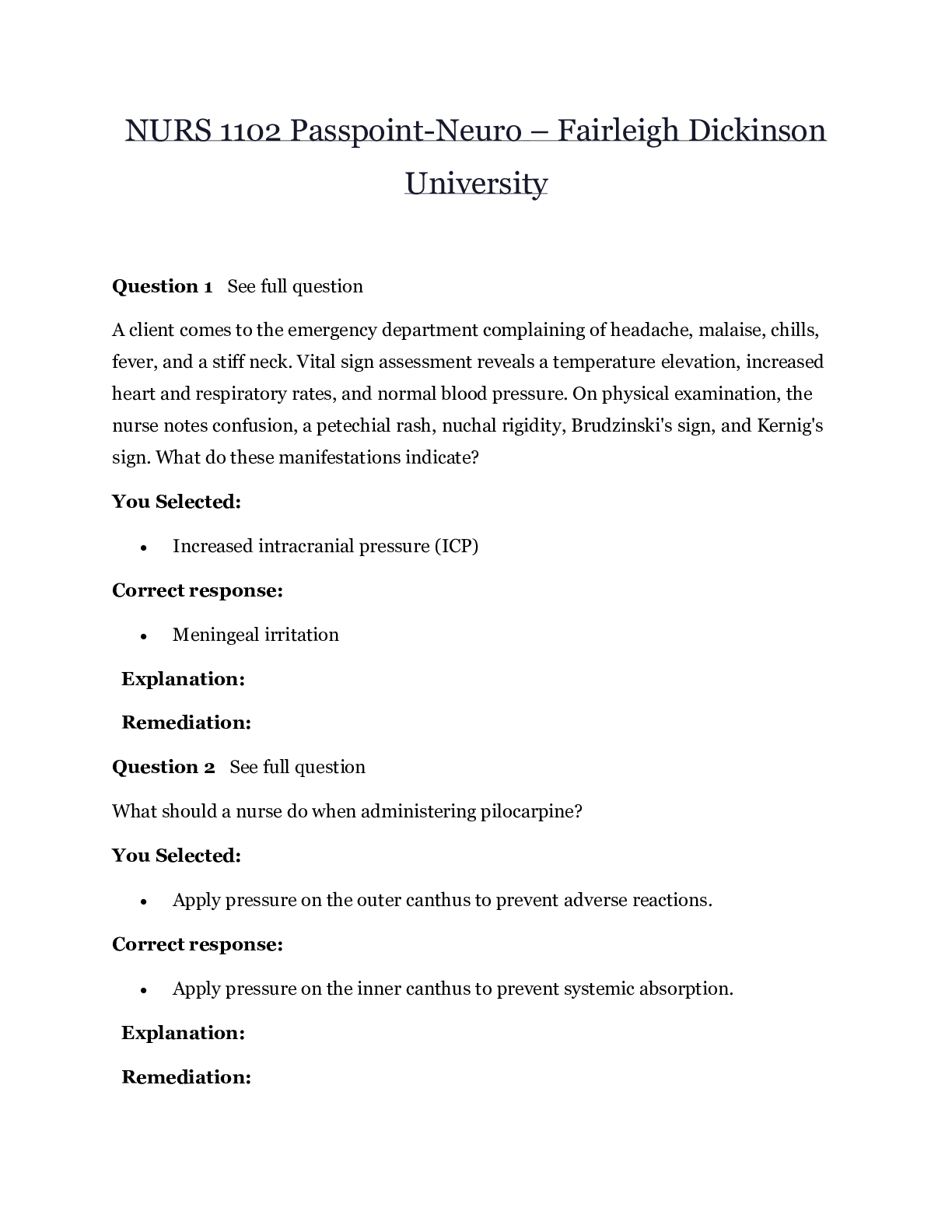
Buy this document to get the full access instantly
Instant Download Access after purchase
Add to cartInstant download
We Accept:

Reviews( 0 )
$16.50
Document information
Connected school, study & course
About the document
Uploaded On
Aug 15, 2020
Number of pages
212
Written in
Additional information
This document has been written for:
Uploaded
Aug 15, 2020
Downloads
0
Views
73














